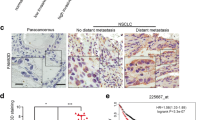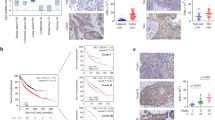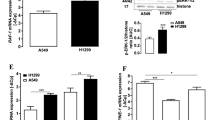Abstract
Background
Non-small cell lung cancers (NSLC) are aggressive cancers that are insensitive to chemotherapies and accounts for nearly 33% of all cancer deaths in the United States. Two hallmarks of cancer that allow cells to invade and metastasize are sustained proliferation and enhanced motility. In this study we investigate the relationship between urokinase plasminogen activator (uPA)/uPA receptor (uPAR) signaling and Na+/H+ exchanger isoform 1 (NHE1) expression and activity.
Methods and results
The addition of 10nM uPA increased the carcinogenic potential of three NSCLC cell lines, NCI-H358, NCI-H460, and NCI-H1299. This included an increase in the rate of cell proliferation 1.6 to 1.9 fold; an increase in the percentage of cells displaying stress fibers 3.05 to 3.17 fold; and an increase in anchorage-independent growth from 1.64 to 2.0 fold. In each of these cases the increase was blocked when the experiments were performed with NHE1 inhibited by 10 μM EIPA (ethylisopropyl amiloride). To further evaluate the role of uPA/uPAR and NHE1 in tumor progression we assessed signaling events using full-length uPA compared to the uPA amino terminal fragment (ATF). Comparing uPA and ATF signaling in H460 cells, we found that both uPA and ATF increased stress fiber formation approximately 2 fold, while uPA increased matrix metalloproteinase 9 (MMP9) activity 5.44 fold compared to 2.81 fold for ATF. To expand this signaling study, two new cell lines were generated, one with reduced NHE1 expression (H460 NHE1 K/D) and one with reduced uPAR expression (H460 uPAR K/D). Using the K/D cell lines we found that neither uPA nor ATF could stimulate stress fiber formation or MMP9 activity in cells with dramatically decreased NHE1 or uPAR expression. Finally, using in vivo tumor formation studies in athymic mice we found that when mice were injected with H460 cells 80% of mice formed tumors with an average volume of 390 mm3. This was compared to 20% of H460 uPAR K/D injected mice forming tumors with an average volume of 15 mm3 and 10% of H460 NHE1 K/D injected mice forming tumors with an average volume of 5 mm3.
Conclusion
Taken together, these data demonstrate that uPA/uPAR-mediated tumor progression and metastasis requires NHE1 in NSCLC cells and suggests a potential therapeutic approach to blocking cancer progression.










Similar content being viewed by others
References
Johnson DH, B.W., Carbone DP, et al. Johnson DH, Blot WJ, Carbone DP, et al., Clinical Oncology. 4 ed. Cancer of the Lung: non-small cell lung cancer and small cell lung cancer, ed. A.J. Abeloff MD, Niederhuber JE, Kastan MB, McKena WG. 2008, Philadelphia: Churchill Livingstone Elsevier. Chapter 76.
D. Hanahan, R.A. Weinberg, Hallmarks of cancer: the next generation. Cell 144(5), 646–74 (2011)
M.V. Carriero et al., Structure-based design of an urokinase-type plasminogen activator receptor-derived peptide inhibiting cell migration and lung metastasis. Molecular cancer therapeutics 8(9), 2708–17 (2009)
J.S. Rao et al., Inhibition of invasion, angiogenesis, tumor growth, and metastasis by adenovirus-mediated transfer of antisense uPAR and MMP-9 in non-small cell lung cancer cells. Mol Cancer Ther 4(9), 1399–408 (2005)
A.K. Nalla et al., Targeting MMP-9, uPAR, and cathepsin B inhibits invasion, migration and activates apoptosis in prostate cancer cells. Cancer gene therapy 17(9), 599–613 (2010)
F. Blasi, P. Carmeliet, uPAR: a versatile signalling orchestrator. Nature reviews. Molecular cell biology 3(12), 932–43 (2002)
F. Blasi, N. Sidenius, The urokinase receptor: focused cell surface proteolysis, cell adhesion and signaling. FEBS letters 584(9), 1923–30 (2010)
H.W. Smith, C.J. Marshall, Regulation of cell signalling by uPAR. Nature reviews. Molecular cell biology 11(1), 23–36 (2010)
D. Veale, G. Needham, A.L. Harris, Urokinase receptors in lung cancer and normal lung. Anticancer research 10(2A), 417–21 (1990)
G. Liu, M.A. Shuman, R.L. Cohen, Co-expression of urokinase, urokinase receptor and PAI-1 is necessary for optimum invasiveness of cultured lung cancer cells. International journal of cancer. Journal international du cancer 60(4), 501–6 (1995)
A.E. Dear, R.L. Medcalf, The urokinase-type-plasminogen-activator receptor (CD87) is a pleiotropic molecule. European journal of biochemistry/FEBS 252(2), 185–93 (1998)
G.J. Steffens et al., The complete amino acid sequence of low molecular mass urokinase from human urine. Hoppe-Seyler’s Zeitschrift fur physiologische Chemie 363(9), 1043–58 (1982)
L. Ossowski, J.A. Aguirre-Ghiso, Urokinase receptor and integrin partnership: coordination of signaling for cell adhesion, migration and growth. Current opinion in cell biology 12(5), 613–20 (2000)
K. Dass et al., Evolving role of uPA/uPAR system in human cancers. Cancer treatment reviews 34(2), 122–36 (2008)
C. Martin et al., Intracellular pH gradients in migrating cells. American journal of physiology. Cell physiology 300(3), C490–5 (2011)
S.K. Parks, J. Chiche, J. Pouyssegur, pH control mechanisms of tumor survival and growth. Journal of cellular physiology 226(2), 299–308 (2011)
M.E. Meima, J.R. Mackley, D.L. Barber, Beyond ion translocation: structural functions of the sodium-hydrogen exchanger isoform-1. Curr Opin Nephrol Hypertens 16(4), 365–72 (2007)
C. Stock, A. Schwab, Protons make tumor cells move like clockwork. Pflugers Archiv: European journal of physiology 458(5), 981–92 (2009)
BA Webb et al., Dysregulated pH: a perfect storm for cancer progression. Nature reviews. Cancer (2011)
M Wallert et al., alpha-(1) adrenergic receptor-induced cytoskeletal organization and cell motility in CCL39 fibroblasts requires Phospholipase D1. Journal of cellular biochemistry, (2011)
J. Taves et al., Sodium hydrogen exchanger and phospholipase D are required for alpha1-adrenergic receptor stimulation of metalloproteinase-9 and cellular invasion in CCL39 fibroblasts. Arch Biochem Biophys 477(1), 60–6 (2008)
S. Li et al., Inhibition of proliferation and apoptosis induced by a Na+/H + exchanger-1 (NHE-1) antisense gene on drug-resistant human small cell lung cancer cells. Oncology reports 21(5), 1243–9 (2009)
J. Pouyssegur et al., A specific mutation abolishing Na+/H + antiport activity in hamster fibroblasts precludes growth at neutral and acidic pH. Proceedings of the National Academy of Sciences of the United States of America 81(15), 4833–7 (1984)
J.A. Thomas et al., Intracellular pH measurements in Ehrlich ascites tumor cells utilizing spectroscopic probes generated in situ. Biochemistry 18(11), 2210–8 (1979)
M.A. Wallert, O. Frohlich, Na + -H + exchange in isolated myocytes from adult rat heart. Am J Physiol 257(2 Pt 1), C207–13 (1989)
E.E. Vomhof-DeKrey, J.S. Haring, G.P. Dorsam, Vasoactive intestinal peptide receptor 1 is downregulated during expansion of antigen-specific CD8 T cells following primary and secondary Listeria monocytogenes infections. Journal of neuroimmunology 234(1–2), 40–8 (2011)
C.W. Crowley et al., Prevention of metastasis by inhibition of the urokinase receptor. Proceedings of the National Academy of Sciences of the United States of America 90(11), 5021–5 (1993)
Y.X. Chen, E.R. O’Brien, Ethyl isopropyl amiloride inhibits smooth muscle cell proliferation and migration by inducing apoptosis and antagonizing urokinase plasminogen activator activity. Can J Physiol Pharmacol 81(7), 730–9 (2003)
H. Matthews, M. Ranson, M. J. Kelso, Anti-tumour/metastasis effects of the potassium-sparing diuretic amiloride: An orally active anti-cancer drug waiting for its call-of-duty? International journal of cancer. Journal international du cancer (2011)
S. Ghosh et al., Functional relevance of urinary-type plasminogen activator receptor-alpha3beta1 integrin association in proteinase regulatory pathways. The Journal of biological chemistry 281(19), 13021–9 (2006)
C.H. Tang et al., Signaling through urokinase and urokinase receptor in lung cancer cells requires interactions with beta1 integrins. Journal of cell science 121(Pt 22), 3747–56 (2008)
S. Duriseti et al., Antagonistic anti-urokinase plasminogen activator receptor (uPAR) antibodies significantly inhibit uPAR-mediated cellular signaling and migration. The Journal of biological chemistry 285(35), 26878–88 (2010)
Y. Wei et al., Urokinase receptors are required for alpha 5 beta 1 integrin-mediated signaling in tumor cells. The Journal of biological chemistry 282(6), 3929–39 (2007)
M. Raftopoulou, A. Hall, Cell migration: Rho GTPases lead the way. Dev Biol 265(1), 23–32 (2004)
S. Pellegrin, H. Mellor, Actin stress fibres. Journal of cell science 120(Pt 20), 3491–9 (2007)
S.F. Yang et al., Increased plasma levels of urokinase plasminogen activator and matrix metalloproteinase-9 in nonsmall cell lung cancer patients. Clin Chim Acta 354(1–2), 91–9 (2005)
S.J. Reshkin et al., Phosphoinositide 3-kinase is involved in the tumor-specific activation of human breast cancer cell Na(+)/H(+) exchange, motility, and invasion induced by serum deprivation. J Biol Chem 275(8), 5361–9 (2000)
L. Kraus-Berthier et al., Histology and sensitivity to anticancer drugs of two human non-small cell lung carcinomas implanted in the pleural cavity of nude mice. Clinical cancer research: an official journal of the American Association for Cancer Research 6(1), 297–304 (2000)
A. Estreicher et al., The receptor for urokinase type plasminogen activator polarizes expression of the protease to the leading edge of migrating monocytes and promotes degradation of enzyme inhibitor complexes. The Journal of cell biology 111(2), 783–92 (1990)
L.Y. Bourguignon et al., CD44 interaction with Na + -H + exchanger (NHE1) creates acidic microenvironments leading to haluronidase-2 and cathepsin B activation and breast tumor cell invasion. J Biol Chem 279(26), 16991–7007 (2004)
W. Yang et al., Inhibition of Na(+)/H(+) exchanger 1 by 5-(N-ethyl-N-isopropyl) amiloride reduces hypoxia-induced hepatocellular carcinoma invasioin and motility. Cancer Lett 295(2), 198–204 (2010)
Y. Lin et al., NHE1 mediates MDA-MB-231 cells invasion through the regulation of MT1-MMP. Exp Cell Res 317(14), 2031–40 (2011)
H. Allgayer, Translational research on u-PAR. European journal of cancer 46(7), 1241–51 (2010)
D.A. Nikolova et al., Cetuximab attenuates metastasis and u-PAR expression in non-small cell lung cancer: u-PAR and E-cadherin are novel biomarkers of cetuximab sensitivity. Cancer research 69(6), 2461–70 (2009)
S. Shetty, S. Idell, Posttranscriptional regulation of urokinase receptor gene expression in human lung carcinoma and mesothelioma cells in vitro. Molecular and cellular biochemistry 199(1–2), 189–200 (1999)
R. Wang et al., Tumor-associated macrophages provide a suitable microenvironment for non-small lung cancer invasion and progression. Lung cancer, (2011)
J.B. Wyckoff et al., ROCK-and myosin-dependent matrix deformation enables protease-independent tumor-cell invasion in vivo. Current biology: CB 16(15), 1515–23 (2006)
M. Baumgartner, H. Patel, D.L. Barber, Na(+)/H(+) exchanger NHE1 as plasma membrane scaffold in the assembly of signaling complexes. Am J Physiol Cell Physiol 287(4), C844–50 (2004)
S. Kunigal et al., SPARC-induced migration of glioblastoma cell lines via uPA-uPAR signaling and activation of small GTPase RhoA. International journal of oncology 29(6), 1349–57 (2006)
M. Jo et al., Cooperativity between the Ras-ERK and Rho-Rho kinase pathways in urokinase-type plasminogen activator-stimulated cell migration. The Journal of biological chemistry 277(14), 12479–85 (2002)
T. Mitsudomi et al., Mutations of ras genes distinguish a subset of non-small-cell lung cancer cell lines from small-cell lung cancer cell lines. Oncogene 6(8), 1353–62 (1991)
C. Legrand et al., uPA/plasmin system-mediated MMP-9 activation is implicated in bronchial epithelial cell migration. Experimental cell research 264(2), 326–36 (2001)
I. Henneke et al., Inhibition of urokinase activity reduces primary tumor growth and metastasis formation in a murine lung carcinoma model. American journal of respiratory and critical care medicine 181(6), 611–9 (2010)
M.J. Duffy, The urokinase plasminogen activator system: role in malignancy. Current pharmaceutical design 10(1), 39–49 (2004)
S. Linder, The matrix corroded: podosomes and invadopodia in extracellular matrix degredation. Trends in Cell Biology 17(3), 107–117 (2007)
G. Busco et al., NHE1 promotes invadopodial ECM proteolysis through acidification of the peri-invadopodial space. The FASEB Journal, 24(10): 3903–3915
L.K. Putney, D.L. Barber, Expression profile of genes regulated by activity of the Na-H exchanger NHE1. BMC Genomics 5(1), 46 (2004)
D. Zhou et al., Na+/H + exchanger 1 deficiency alters gene expression in mouse brain. Physiological genomics 18(3), 331–9 (2004)
Author information
Authors and Affiliations
Corresponding author
Additional information
This work was supported by National Institutes of Health Grant 1 R15 HL074924-01A1
Rights and permissions
About this article
Cite this article
Provost, J.J., Rastedt, D., Canine, J. et al. Urokinase plasminogen activator receptor induced non-small cell lung cancer invasion and metastasis requires NHE1 transporter expression and transport activity. Cell Oncol. 35, 95–110 (2012). https://doi.org/10.1007/s13402-011-0068-y
Accepted:
Published:
Issue Date:
DOI: https://doi.org/10.1007/s13402-011-0068-y




